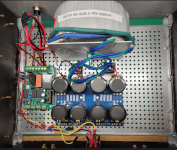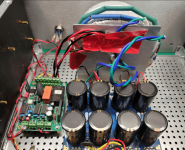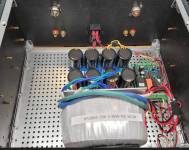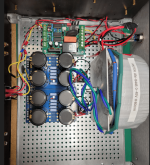Thank you! I replaced the zener with 1/2W and reduced R19 to 15K/1W. Now both channels sounds beautiful 🙂See post 4889 above. You may have a small oscillation on voltage peaks...
I have only 25+25 vac 500 VA could it work too for only 50 watts ?Okay, diyaudio.com member Currentflow pointed me to the answer to my voltage question here: http://www.diyaudio.com/forums/solid-state/192431-diyab-amp-honey-badger-4.html#post2648883 in that post by OStripper.
So, it is possible to use a 28+28vac transformer just fine. It is going to make about 42vdc rails. That is enough to X-Max most or many 8" and smaller woofers. More to the point clear vocals don't come out of madly shaking woofers of maxed out 2 way speakers. Thus the lesser transformer is probably enough voltage if you have 2 way speakers. It simply makes a smaller scale amplifier. You can "right size" if you want to.
What it means to me is that this opens up more possible transformer selections, much of which is less expensive in some way. With the 28+28vac transformer, the caps can be inexpensive 63v models, and you can use double-parallel output with less ballast resistor loss and less expense which is something to consider if your speakers didn't happen to need a super power amplifier.
Not everyone has speakers capable of handling or doing anything useful with 150 watts and therefore not everyone needs 60+60vdc rails, and then maybe not everyone needs the price tag for extra power not used.
At least we have a transformer voltage range: 28+28vac to 45+45vac or anywhere in-between.
I would do that more expensive approach if there was future plans to upgrade the power handling of my speakers. With a 150w amplifier, of course the upgrade speakers would be 3 way or more so that the vocals didn't get scrambled/shaken when the amplifier was run all the way to its maximum potential.
Why is a 15k/1W resistor needed? I mean even if the rail voltage is as high as 70V, (70-12)^2 / 15k = 0.225W. Is there a known artifact related to the Zener power (over-)rating? Thanks, MiklosPlease refer to my schematic.
The problem was the zener diode and R19.
R19 was to large and the zener diodes power rating wasto high.
I posted a lot of information about this years ago and have helped many members out with this solution.
100 ohm base resistors into Q3 and Q4 can also help.
Central is Excellent i bought 20 tin lead mpsa18 and got 6 almost perfect match pairs for LTP hfe was 670 to 690these are most consisten batch of any small signal transistor i have ever purchased i also purchased other low noise part i think it was mps8097 and also very close consistency i am not afraid to say they are too notch producer and would not hesitate to recommend them to anyone also they are one of the few that a magnetwill not pick up any trace of steel in them truly important for low noise in audio circuit every part i buy i check Onsemi had few batches of ksc1845 few years back made in china with tin plated steel leads Steel is BAD for Audio plating helps but does not remove all noiseCentral Semi is good I’ve used them without an issue.
no I did not yet Thank You if u are in need of MP for ltp I have several matches in 650 to 700 range I will donate to the cause if you are interested the Mpsa18 tin lead are super low noise best lead material too
Sorry, but without punctuation and almost without capitalisation it is hard, if not impossible for me as a non native speaker to follow 😒 ...Central is Excellent i bought 20 tin lead mpsa18 and got 6 almost perfect match pairs for LTP hfe was 670 to 690these are most consisten batch of any small signal transistor i have ever purchased i also purchased other low noise part i think it was mps8097 and also very close consistency i am not afraid to say they are too notch producer and would not hesitate to recommend them to anyone also they are one of the few that a magnetwill not pick up any trace of steel in them truly important for low noise in audio circuit every part i buy i check Onsemi had few batches of ksc1845 few years back made in china with tin plated steel leads Steel is BAD for Audio plating helps but does not remove all noise
Best regards!
You know what? Most leads are made from steel, always have been except for hermetic packages using Kovar or similar (remember tubes?). There is zero wrong with steel leads.
Just saying, I hate that myth!
Just saying, I hate that myth!
I agree, but usually an alloy... If for nothing else, to give them a better ability to be bent without breaking.
60W at 8R ... but you could drive 2R loads (37V SOA) @ 200W. VAS current source might have to be adjusted , as would the LTP CCS.I have only 25+25 vac 500 VA could it work too for only 50 watts ?
35V is about the minimum Badger spec.
Man , the amp run soooo cool at that voltage.
Not True most leads are tinned copper and show me a single die that is diffused with steel does not exist only aluminum or Copper leads was used on cheap TO-92 from China to save money get a magnet and all Transistors you have only the newer china stuff will attract to it all my med power high power transistors from toshiba onsemi sanken not one will be attracted to magnet unless it's a fake copper is an excellent inductor fair dissipator aluminum is good at both reason its used for heatsinking steel is POOR at BOTH and it does distort signal more than either of them basic science on grade school level here dont take my word just refer to periodic table of elements and there is your undisputed answer
A ton of resistors and other parts have steel in their leads, as my nippers get magnetized, and the damn leads stick to them. I wasn't referring to semis, just leads in general.
yes resistors have mostly tin/steel and the windings of most is nickel/iron sometimes tungsten which is used for majority of wire wound and film resistors steel is used because it's cheap conductor tin plating negates most of its ill effect on signals passing through but in general whenever you can avoid it is a good thing steel is also bad because of its high inductance the resistors in BOM the KOA plate resistors are not magnetic I wad thrilled when magnet was not attracted to it and they seem to work well barely get warm vs blazing hot wirewound resistors avoid steel when you can it is not good for audio signals
the 1 percent yageo resistors in Bom are non magnetic also I had some Chinese ss9014 for LTP but used the non magnetic tin lead mpsa18 from central they worked great my offset was almost unmeasurable at startup on both boards most will not invest the time to measure and match every component like I did I spent way more time measuring than I did building but end result was zero issues great measurements no surprises at all Take Pride in your Work IT IS YOUR SIGNATURE AND REPRESENTATIVE OF WHO YOU ARE . A Huge Thank You To Pete Ostripper for all the time he has invested for Our Benefit you have my sincere gratitude for that and plan to enjoy this amplifier for many years KNOWLEDGE IS PURE POWER SHARE YOURS AND ENRICH THE THE LIVES OF THOSE AROUND YOU
Hi all,
I've been studying this forum for several months. Started ordering parts, sticking to the BOM.
I've received the Antek AS 8445 0-45V @800VA transformer.
I've built FW clone amps, so have some experience.
My question: this transformer has 4 addtional wires running from it. I know what to do with the red & black, and green and blue, but not what to do with the brown & brown 18V or orange & orange 12V.
If I don't use them do I just tape them up?
As always, thanks for the assistance.
I'm looking forward to slowly assembling this amp.
I've been studying this forum for several months. Started ordering parts, sticking to the BOM.
I've received the Antek AS 8445 0-45V @800VA transformer.
I've built FW clone amps, so have some experience.
My question: this transformer has 4 addtional wires running from it. I know what to do with the red & black, and green and blue, but not what to do with the brown & brown 18V or orange & orange 12V.
If I don't use them do I just tape them up?
As always, thanks for the assistance.
I'm looking forward to slowly assembling this amp.
All those four unused wires must be individual isolated and not connected to anything. It's also good practice to mechanical stabilize them so they wont go on a journey through the case.
Chiptech, if you want a low power LED pilot light you can use the 12 V winding with a small diode and cap. As an alternative I connect the LED across from V+ to V- to give a visual indication of when the caps are discharged but that burns up a couple of watts.
I've assembled my PSU and wiring, including a Mark Johnson Low voltage on/off circuit that I have used in all my builds. Can't recommend it enough.
The Antek transformers I've used in the FW amps all had a ground wire. The Antek AN-8445 does not.
I'm using the same grounding scheme as before:
I'm using a SL-22 inrush limiter to the ground point.
I will trim excess transformer wires later in the build.
I haven't turned this on yet. Anything I'm missing in the grounding for the PSU?
Thanks
The Antek transformers I've used in the FW amps all had a ground wire. The Antek AN-8445 does not.
I'm using the same grounding scheme as before:
I'm using a SL-22 inrush limiter to the ground point.
I will trim excess transformer wires later in the build.
I haven't turned this on yet. Anything I'm missing in the grounding for the PSU?
Thanks
Attachments
I used the steel cge from a nad 955 that i had laying around its transformer almost identical size it shields the field around transformer that can show up as hum in your speakers they sell bands that wrap around torroid and shield it as well i think i saw it listed on anteks website in accessories that should help minimize that issue using cordless drill and a vise to twist wires for input and output also helps to shield from this routing wires away from amp board instead of crossing over them by utili all of these things helps to make it a quiet Amplifier well at least till you crank up the volume on your favorite music
- Home
- Amplifiers
- Solid State
- diyAB Amp The "Honey Badger" build thread



